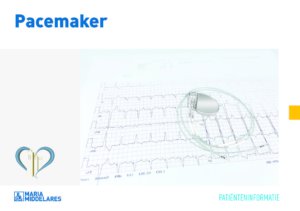Pacemaker (PM) implantation
What is it?
What is it?If you have a slow heart rate or if there are pauses in your heart rhythm, the implantation of a pacemaker may be indicated. A pacemaker is a small device that takes over the job of the natural pacer (the sinus node) or of the conduction pathways (AV node). The pacemaker is on stand-by until the moment that the heart rate is lower than a pre-set limit. At that moment, the pacemaker gives electrical impulses so that the heart contracts.
The pacemaker system consists of:
- a small device (the pacemaker with the battery)
- one, two or three pacing lead(s) to the heart
What is the process?
What is the process?Preparation
You will be admitted to the Cardiology Department. You need to be fasting: that means at least two hours for clear fluids (only water, tea and coffee), at least six hours for a light meal and dairy products and at least eight hours for a regular meal. Medication may be taken as agreed with the physician.
You will be given a surgical gown to wear. If no recent laboratory results are available, blood samples may be collected. The nurse places an IV line in your arm to administer medication later.
The procedure is performed in the cardiac catheterisation room.

The procedure
You will take your place on the examination table. Adhesive electrodes are attached to monitor your heart rhythm. You will be given antibiotics through the IV drip as protection against infection. An area of skin on the left shoulder measuring 10 by 10 cm is shaved and disinfected, and adhesive sterile sheets are placed around it. A local anaesthetic is injected to numb the skin and the underlying subcutaneous tissue.
The physician makes a 4-mm small incision. A small vein between your shoulder muscles will be located so that the pacing wires can be guided to the heart. For the third pacing lead, the physician opens a larger vein under the collar bone. The electrodes are placed in the right heart cavities and the contacts are checked for quality. Once the pacing leads are secured, a space is created under the skin near the shoulder for the pacemaker or defibrillator. The skin is closed with absorbable sutures and the wound is covered with a plaster. The procedure takes approximately one hour. If all checks of the device are found to be in order the next day, you may go home.
Aftercare
To prevent infection, the plaster will stay in place for a few days. Do not shower or bathe in the first week. Avoid too much movement of the shoulder girdle.
What are the risks?
What are the risks?- Local bruising is possible but does generally not require much looking after.
- While opening the deep vein, the lung may be accidentally punctured, resulting in a collapsed lung. Radiography is therefore always performed after the procedure to detect this.
- In spite of all precautions, the wound may seldomly become infected. In this case, antibiotics sometimes have to be administered and/or the device removed. In the first weeks after the procedure the electrodes may migrate, which will necessitate another procedure.
Results
ResultsSymptoms that were present before the pacemaker was implanted will disappear quickly after the procedure. You have six monthly follow-up consultations in the outpatients clinic. Telemonitoring may also be helpful in the follow-up. Depending on the usual intensity, the pacemaker battery may last up to ten years. Regular follow-up will indicate when the pacemaker should be replaced.
Leaflet
LeafletSee the leaflet below for more information.
Only available in Dutch:

Pacemaker
DownloadCost estimate
Cost estimateCentres and specialist areas
Centres and specialist areas
Latest publication date: 13/12/2023
Supervising author: Dr Provenier Frank



